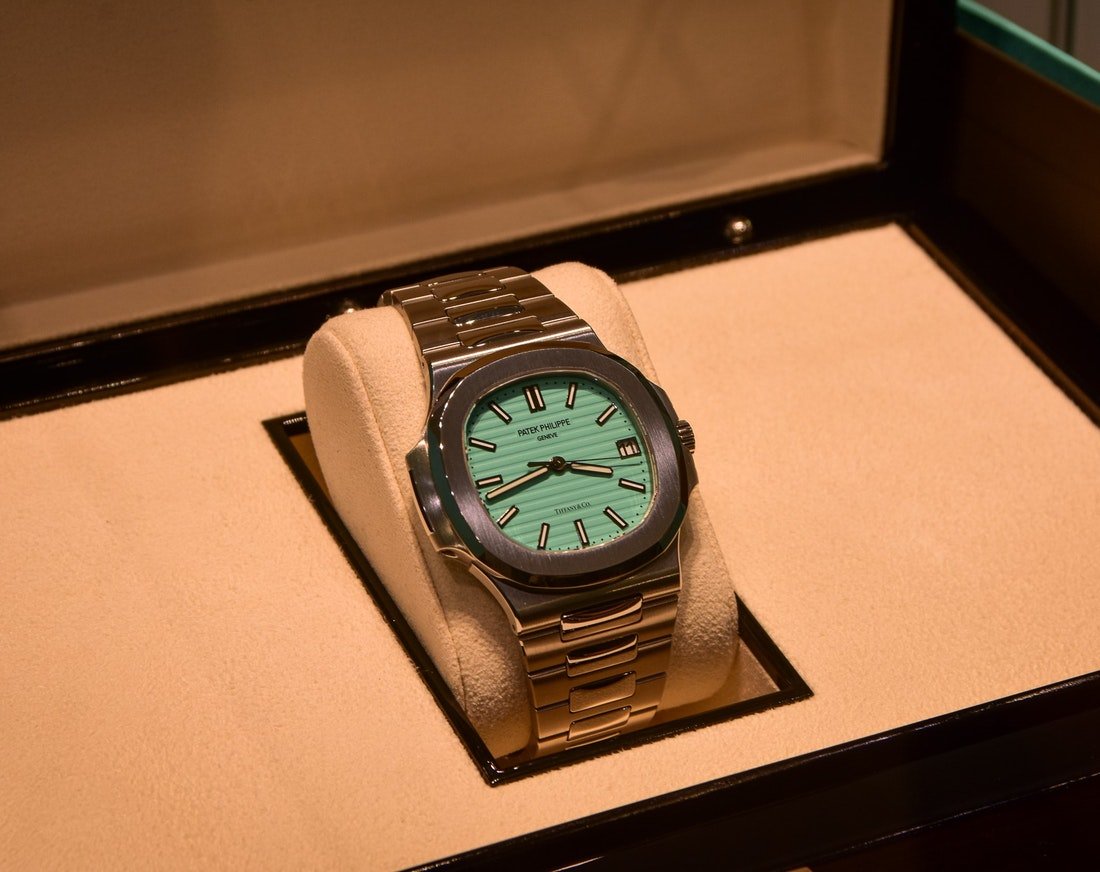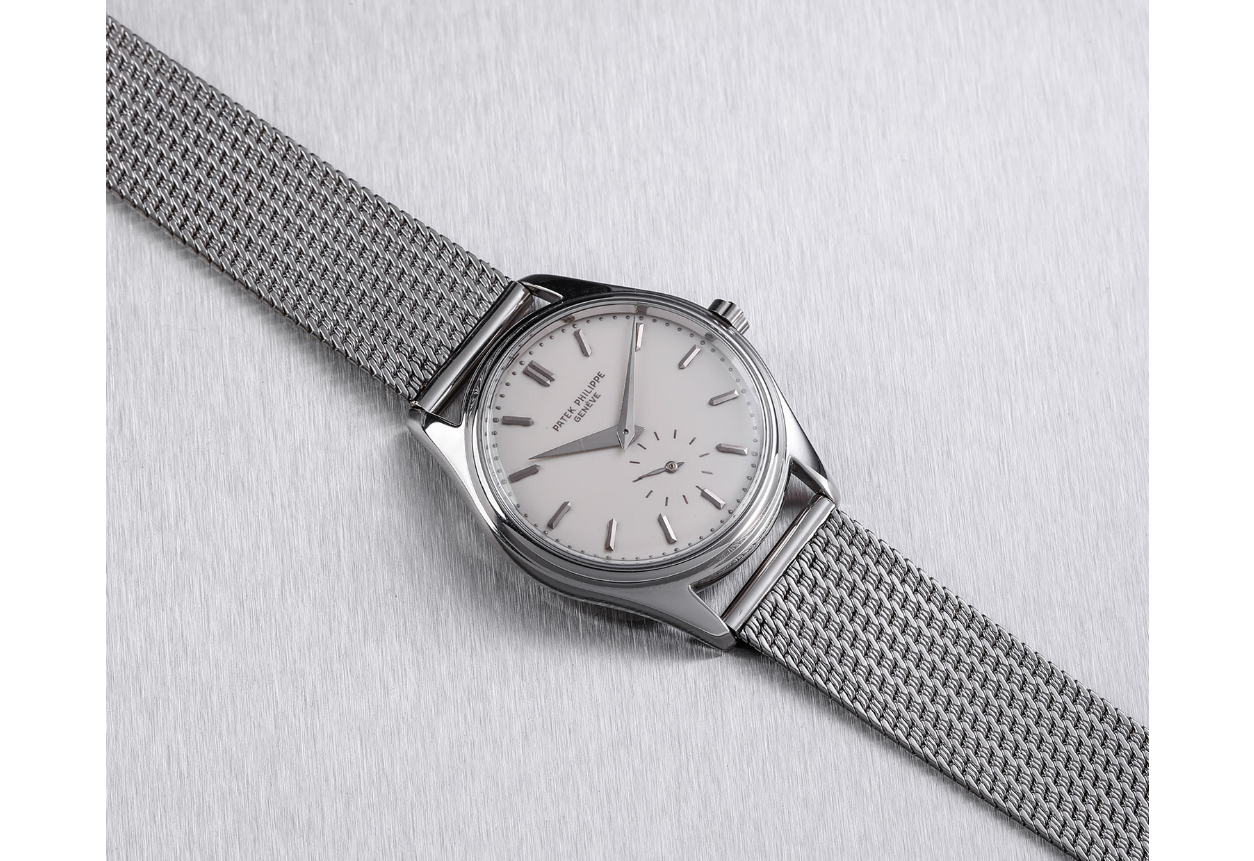Watches old; watches new; watches Tiffany Blue®
Ah, New York during the holidays. The Rockefeller Center tree, Cartier wrapped up like a present worthy of Fifth Avenue, reliving your favorite scenes from Home Alone 2 or Elf.
And of course, watch auctions. I attended a big watch auction in-person for the first time, heading to Phillips on December 11-12.
Sure, there was Lot 1T, the Tiffany Blue®, and we'll get to that. But since this was my first big in-person auction experience, and arguably the first major one in the States with actual attendees since BC (before covid), I wanted to throw together a grab bag of random impressions and thoughts from the weekend that was. Observations big and small, in no particular order of importance.
Watches are getting younger
Look out in the crowd of 100 or so that attended the first day of the Phillips sale, and you wouldn’t have seen a ton of grey hairs. Attendance might be more of a proxy for interest than actual bidding, but ask any auction house and they’ll tell you that registered bidders are getting younger too. Take this recent report, where Phillips said that more than half of its registered bidders were under 40, with 47 percent being first-time registrants to the house. I mean, rapper Rich the Kid showed up on Friday to take a picture with the Tiffany Blue® Nautilus.
Personally, I find it exciting; not that I got into this hobby because it was “cool” (it’s definitely not), but because some of these kids curious about watches might turn into true collectors. Come for the Tiffany Blue®, stay for the 1518s, or something like that.
For so long, watches were an important part of the culture. During the Industrial Revolution, workers actually used them to get to work on time and clock in. Then, World War I and II soldiers used them in planes or in the trenches. Sure, watches became more fashion statements through the 70s-80s, with some of the most “famous” watches being worn by actors or models like Paul Newman, Steve McQueen, or Nina Rindt.
But at some point between then and now, it felt like watches lost their way. They weren’t really part of the cultural conversation the way sneakers, jewelry, or other luxury items were.
It feels like that’s changing. Over the past year, I can’t tell you the number of watch “news” stories that have broken into mainstream conversations: Sure, there’s the Tiffany Blue®, but things like the John Mayer G-Shock and Ryan Gosling’s deal with TAG Heuer also seem to have resonated with my friends who are merely watch-curious. Not to mention the TikToks about “investing” in watches. So, so many TikToks.
To me, it’s exciting that watches are part of the culture again. There are so many things to love and be passionate about: vintage watches with interesting stories, modern independents who are true artisans worth supporting, and everything in between — I only hope that a few of those people who may have been introduced to watches because of the hype discover these stories and stay for a while.
Live auctions should probably be shorter, and with fewer watches
For a lot of watches, I’d argue there’s a fairly well-established market price. Think your modern or five-digit Rolexes, many Omega Speedmaster references, etc. Hell, off the top of my head I can even think of three examples of Daytona Big Red 6263s selling for about the same price (1, 2, 3) in the past month. When a watch like this came up at Phillips while I was sitting in the room, I couldn’t help but think why? It feels unnecessary and potentially counter-productive.
Like, when this Hulk Submariner came under the hammer on Sunday, it felt like the whole room let out a collective eye roll before opening Chrono24 to check the price of the hundreds of examples listed over there right now. Then, as the lot’s price started to climb to 40k, 50k, before eventually hammering at $94.5k, the room did a collective facepalm. WTF?!
First, this is a watch with a known and easily found market price; why does it need to be auctioned off to begin with? Putting it in a live auction subjects the market to the irrational behavior of a couple clowns, and gives ambitious Chrono24 sellers the opportunity to bump their prices after the sale, using this lot as justification.
But more than that, it just feels procedural to put these under the hammer. It’s selling commodities, the same as grain or corn in the pits of the Chicago Mercantile Exchange circa 1921.
If I’m going to make the effort to fly to New York, I only wanna see the good stuff go under the hammer live. Everything else? Sell it in an online auction.
By the way, I totally understand why auctions need to sell these watches, so file this one under “first-world problems” (which, aren’t all watch problems?).
1T®
Patek Philippe Tiffany Blue Nautilus
Okay fine, let's talk Tiffany. Bidding on the Patek Philippe Nautilus ref. 5711 Tiffany Blue® took about 15 minutes, with the eventual winning bid coming from a New York online bidder (if I were going to spend $6m on a watch, I might drive in to bid in-person. Hell, I'd probably hire a driver to bring me to Phillips on Park Ave). The eventual under-bidder was in the room, a bit of a showman who at varying points wandered around the room, talking on the phone while bidding, or talking to a Phillips specialist while indicating to auctioneer Aurel Bacs that he was thinking.
The under-bidder and Aurel kept the bidding fun, providing some levity to it all. It felt like they were winking at each other the whole time. “Isn’t this whole spectacle ridiculous?” Each incremental bid seemed to say. “That a room’s filled up on a Saturday morning to watch a few rich guys bid on a Tiffany Blue watch that was announced literally five days earlier?”
At one point, every subsequent bid was followed by chuckles from the entire room. So many of the hot takes about this watch have taken it so d*mn seriously, so it was refreshing that the bidding felt like the opposite of that. I mean, I could write a piece about what this watch indicates about late-stage capitalism and consumer culture amid a global pandemic, but what fun is that?
Before bidding started, Bacs also made it clear that (for Americans, at least), the purchase price in excess of the fair market value (i.e., the MSRP of $52,000) would be tax-deductible. So think of this as a year-end holiday charitable donation for one collector.
Alexandre Arnault — the son of LVMH CEO Bernard Arnault — who runs Tiffany & Co., sat in the front row for the sale, giving a fist pump as the watch passed $5m. The lanky exec stayed for the sale of lot 1T, but walked out a few lots later.
He wasn’t the only one: The room was full for the sale of 1T, but people slowly filtered out after until the room was mostly empty by the end of day one.
One more thing: Let’s not forget that Tiffany & Co. is an American retailer. I don’t want to get into the whole armchair corporate strategy about how LVMH wants Tiffany & Co. to be the crown jeweler of its portfolio of brands, a formidable adversary to Richemont’s Cartier, and all that. As an American with a healthy sense of American exceptionalism, I just want to say that I love that one of our oldest and proudest retailers has been put on the center stage of the watch world like this.
Odds and ends
Sitting in the room, you notice a lot of weird things you might not notice watching the stream at home. Many of this comes from observing bidders in the room, so with most people choosing to bid via phone or online nowadays, surely you pick up less than you used to. But here are some fun, random things I picked up on:
Lucky Lange: The same collector bought all three Lange 1815 “Homage to Walter Lange” lots, picking up examples in white, yellow, and pink gold, paying a combined $210k for the trio. It’s an example of how one collector can drive up a market.
Wait Just One Merite: the collector who won the Lange Pour la Merite Tourbillon for $530k was also the under-bidder on the Tudor Submariner with a gorgeous tropical dial, which eventually sold for $69k. I have no idea what this guy’s got in his collection, but if it comes anything close to spanning the variety of these two gorgeous lots he bid on, I’d love to see it.
Parrotheads: That tropical Tudor Sub came from the same collection as the full-lume Heuer Autavia ref. 2446. To me, this legitimized the Sub a bit. Someone more cynical than me might look at the gorgeous, even golden hue of that Sub and think it'd been cooked or messed around with. But when you learn that it comes from the same collection as perhaps the best Heuer to come to auction this year, it gives some credence to the Sub's originality. As for the Tudor Submariner itself? The tropical dial made it a bit too illegible for my taste, but it feels like another example of a gorgeous tropical dial going for a huge premium, a small-scale version of the tropical Speedmaster that Phillips sold for $3.1m in Geneva.
Speaking of Heuer: The brand had a nice showing at Phillips. Five Heuer lots were up for auction, and all topped their high estimates. The biggest number came from that full-lume Autavia ref. 2446, which sold for $163k, but even the more bread-and-butter pieces performed well. I didn't like the Carrera 753 NST — the lume was all darkened — but it still attracted bids. Meanwhile, the Carrera 3647N with an MG logo for the British car company is an objectively rare watch. And while it's certainly niche, it still performed well. The easy narrative is that this shows how “the Heuer market is stabilizing after a few years of ups and downs,” but we’ve talked about the reality of Heuer on Significant Lots before. The biggest Heuer “event” of the past few years was the Heuer Parade auction at Phillips in 2017, but that auction was sourced primarily from one collection. For a market to truly thrive, it needs to draw from the entire community for support, along with the knoweldge and passion that comes with it.
The ridiculously gorgeous platinum ref. 2526 with enamel dial
Platinum Patek: For me, the highlight of the entire sale was the platinum Patek ref. 2526 with an enamel dial and special order platinum Gay Freres bracelet. Of course, there's the rarity — there are only a handful of platinum 2526s to begin with, and only 5 known with enamel dials, according to the catalog entry — but what really struck me was the warmth of the watch. Collectors took notice, as it ultimately sold for $441k, but given its rarity, historical importance (as the first automatic watch from Patek), and how f**king beautiful this thing is, the price doesn’t feel like too much (which can’t be said for every lot in this sale).
Matte or gilt dial 1675 — which is your pick?
Matte or Gilt Rolex: On Saturday, Phillips sold a matte dial Rolex GMT-Master and a gilt dial GMT-Master, three lots apart, for the exact same price ($50,400). The gilt dial example was in great condition and has previously sold for much more than it did this time around. So are people just not willing to pay a premium for gilt dial Rolex anymore? Is the practicality of a slightly more modern, more robust matte dial just too good to resist? It’s fascinating to put these two watches side-by-side and see that, in this auction at least, they were worth the exact same.
Sure, retailer stamps are important, but originality is still key. Yea, 1T was the most notable retailer-signed watch of the weekend. But there were others. A Tiffany-signed GMT-Master went for $100k, a crazy premium for a 90s GMT. But originality is still key. Sotheby’s sold a simple Rolex Air-King with a Cartier signature for $10k, off an original estimate of twice that. Problem is, the Cartier stamp had been added later. So sure, retailer signatures are cool, but only if they’re original.
Does anyone actually care about auctions?
Over the two-day sale, Phillips sold more than $35m of watches. The only "press" there to cover the event was Hodinkee (and me, I guess). When the biggest auction house in watches sells that much worth of watches, it feels newsworthy to me. But maybe not. Having been there, observing the sights and sounds for two days, I can attest to the little things you pick up on in the room.
It felt weird to me that no one else was there to truly “report” on the auction. But maybe this is a testament to how nerdy it really is to care about watch auctions, and even the most passionate of enthusiasts wouldn’t care to read a 2,000-word article/grab bag of impressions from the auction room (in that case, joke’s on me for writing this piece; and joke’s on you for reading it!).
Collectors need to control the narrative
Collector Greg Selch’s piles of watches
Which brings me to a related point: Collectors need to control the narrative. With no real press there to cover the event, the auction house controls the narrative of the watches and of the sale. They write up the press release, do a few social posts, and that’s that. But a healthy watch industry needs independent journalism and thoughtful collectors too.
This also happens with dealers — they post a watch on Instagram, tell us why it’s important or that they “sourced it from the original owner,” and spin a narrative of a watch, model, or brand.
And that’s fine: Sellers handle dozens of watches a day, and the good ones are honest and do a lot to support the community. But at the end of the day, auction houses and dealers are in the business of selling watches. Collectors (and journalists) need to do the work to scrutinize the narrative, call watch sellers out on their bullsh*t, and put together a narrative that’s independent of sellers.
The stories matter
Ralph Ellison wearing his Speedmaster, courtesy of Phillips
By the way, it’s not all bad that auction houses, dealers, etc. might control the narrative. Sometimes, they get timepieces that are legitimately historically important or interesting. This season, Phillips (along with the consignor of the watch) did an amazing job telling the story of the Omega Speedmaster owned by author Ralph Ellison. When you walked into the preview, photos of Ellison hung above, proudly on display alongside blown-up images of horological icons from Rolex and Daniels. It was amazing to see an American author — and a Black one, at that — celebrated like this in a watch auction.
This storytelling turned a Speedmaster into a $600k piece of history headed for the Omega Museum.
It’s only partly about the watches
Cheers, and until next year
In general, the online watch community is much too negative for my taste.
But getting together in person in New York for the auctions was like entering a good-vibes-only zone. Over the course of four days I met dozens of amazing collectors, dealers, and auction specialists. All were nice, welcoming, and generous with their time.
So yea, it was fun to see the watches. But it was more fun to meet the people.
It’s also an excellent reminder: People throw barbs online at so many of these institutions — publications, auction houses, etc. — but these are just groups of people trying to do right by the watches. And in most cases, it’s not even that many people. The watch world is still a small one.








